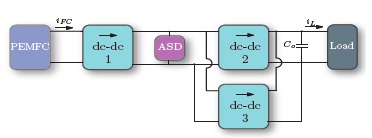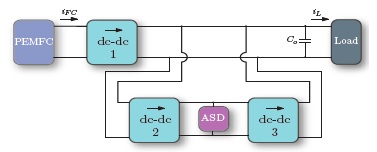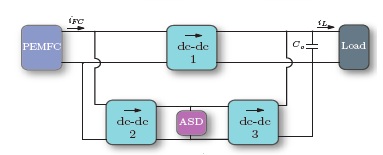- ALL COMPUTER, ELECTRONICS AND MECHANICAL COURSES AVAILABLE…. PROJECT GUIDANCE SINCE 2004. FOR FURTHER DETAILS CALL 9443117328


Projects > ELECTRICAL > 2017 > IEEE > POWER ELECTRONICS
This paper extends the use of the versatile buck boost converter to power manage a parallel hybrid system topology as an alternative to the well-known serial hybrid (SH) topology and the most recent series-parallel hybrid (SPH) topology. These systems utilize a proton exchange membrane fuel cell (PEMFC) as the primary source in combination with an auxiliary storage device (ASD), and the selected converter is in charge of the power management between the sources (FC or ASD) and the load. Therefore, the converter has a very important role in the system since it is responsible of ensuring a dc bus voltage regulation with a safe and reliable operation of the entire system while also guarantee a high power conversion efficiency. Hence, this is the third topology where the coupled-inductor dc-dc buck-boost converter is studied to demonstrate and exploit its advantages such as noninverting voltage step–up and step–down, high efficiency, regulation of input and output currents and low ripple values, and the ability to change from input to output current regulation loop, suddenly and smoothly, and vice versa. In order to determine which topology (SH, PH, or SPH) exhibits the highest power conversion efficiency under a certain load profile it is important to ensure a fair efficiency comparison that will only reflect the properties of the topology and not its individual components. Therefore, the same design criteria, the same control and the same components were used for all the studied topologies.
Hybridization Topologies.
A PEMFC-based PH power system with an ASD and three current controlled dc-dc converters has been simulated and experimentally tested. The system’s design criteria, components, and features are similar to the ones of the recently published SH and SPH power system topologies. The efficiency comparison between the three different hybrid power system topologies was obtained by testing them with a generic cyclic profile of the load power, which commonly appears in the distributed generation systems. The same versatile non-inverting buck-boost modules performed the tasks of dc-dc converters in the three investigated topologies. The voltages of these dc-dc converters were controlled indirectly by controlling the converters’ input and output currents. The usage of the same converter modules reduces the costs and development time, as well as simplifies the control design. Another benefit is a fairer efficiency comparison between the studied topologies, since the losses in each power converter in all systems can be assumed as equal. Thus the effects of components are eliminated and an exclusively topology dependent power conversion efficiency comparison of the three studied hybrid topologies is achieved. In addition, the usage of the same power converter modules simplifies the mathematical analysis and derivation of the analytical efficiency functions.
FC-based hybrid power system topologies SH topology

PH topology

SPH topology
